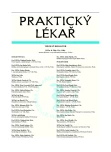-
Medical journals
- Career
Evoluce a evoluční teorie pro lékaře
VI. Evo-devo
(evoluční vývojová biologie)
Authors: F. Koukolík
Authors‘ workplace: Primář: MUDr. František Koukolík DrSc ; Národní referenční laboratoř prionových chorob ; Fakultní Thomayerova nemocnice s poliklinikou, Praha ; Oddělení patologie a molekulární medicíny
Published in: Prakt. Lék. 2010; 90(6): 327-332
Category: Editorial
Overview
Evolutionary developmental biology, informally evo-devo, is a biological discipline that compares developmental processes of different life forms. It deals with origin and evolution of the embryonic development, developmental plasticity in evolution, how ecology impacts the development and evolutionary change and basis of homoplasy and homology. Evo-devo completes and changes neodarwinian synthesis due to a new view on genetics of evolutionary adaptation. Basic research of evo-devo produces fundamental pieces of knowledge and future therapy of complex diseases eg. Alzheimer’s disease and malignant tumours.
Key words:
Evo-devo, modularity, evolutionary adaptation.
Sources
1. Adachi, Y., Hauck, B., Clements, J. et al. Conserved cis-regulated modules mediate complex neural expression paterns of the eyless gene in the Drosophila brain. Mech. Dev. 2003, 120, p. 113-1126.
2. Carroll, S.B. Homeiotic genes and the evolution of arthropods and chordates. Nature 1995, 376, p. 479-485.
3. Carroll, S.B. The making of the fittest. New York: WW. Norton and Company, 2006.
4. Carroll, S.B. Evo-devo and an expanding evolutionary synthesis. A genetic theory of morphological evolution. Cell 2008, 134, p. 25-36.
5. Davidson, E.H., Erwin, D.H. Gene regulatory network and the evolution of animal body plans. Science 2006, 311, p. 796-800.
6. De Robertis, E.M. Evo-devo: variation on ancestral themes. Cell 2008, 132, p.185-195.
7. Hoekstra, H.E., Coyne, J.A. The locus of evolution: evo-devo and the genetics of adaptation. Evolution Int. J. Org. Evolution 2007, 61, p. 996-1016.
8. Hyde, W.T., Crowley, T.J., Baum, S.K. et al. Neoproterozoic „snowball Earth“ simulations with a coupled climate / ice sheet model. Nature 2000, 405, p. 425-429.
9. Koukolík, F. Evoluce a evoluční teorie pro lékaře. V. Darwinovy teorie evoluce. Prakt. lék., 2010; 90, s 268–273.
10. McMahon, A.P., Ingham, O.W., Tabin, C.J. Developmental roles and clinical significance of hedge hog signalling Curr. Top. Dev. Biol. 2003, 53, p. 1-114.
11. Mueller, G.B. Evo-devo as a discipline. In: Minelli A, Fusco G. (eds.). Evolving pathways: key themes in evolutionary developmental biology. Cambridge: Cambridge University Press 2008, p. 3-29.
12. Monod, J., Jacob, F. Teleonomic mechanisms in cellular metabolism, growth, and differentiation”. Cold Spring Harbor symposia on quantitative biology 1961, 26, p. 389–401.
13. Tax, S., Callender, C. (eds.) Evolution after Darwin; the University of Chicago Centennial. Chicago: University of Chicago Press, 1960.
14. Valentine, J.W. On the origin of phyla. Chicago: University of Chicago Press, 2004.
15. Wapinski, I., Pfeffer, A., Friedman, N. et al. Natural history and evolutionary principles of gene duplication in fungi. Nature 2007, 449, p. 54-61.
16. Werneburg, I. A standard system to study vertebrate embryos. PLoS ONE 2009; 4(6): e5887. doi:10.1371/journal.pone.0005887.
Labels
General practitioner for children and adolescents General practitioner for adults
Article was published inGeneral Practitioner

2010 Issue 6-
All articles in this issue
-
Evoluce a evoluční teorie pro lékaře
VI. Evo-devo
(evoluční vývojová biologie) - The etiology and new clinical-etiology-anatomy-pathophysiology (CEAP) classification of extremitovascular ischemic disease
- Acellular porcine dermis in local treatment of diabetic food syndrome
- Smoking and type 2 diabetes mellitus
- Foreign-born and homeless persons – new epidemiologic and social factors in the control of tuberculosis in Prague
- The gap between the objective and the subjective, patient stress, psychosomatics
- Gambling and the work environment
- Supervision as a method of prevention of burn-out syndrome in health care professionals
- Adverse effects of non-steroidal anti-inflammatory drugs
- Activation of processes of change in adolescent smokers
-
Evoluce a evoluční teorie pro lékaře
- General Practitioner
- Journal archive
- Current issue
- Online only
- About the journal
Most read in this issue- Adverse effects of non-steroidal anti-inflammatory drugs
- The gap between the objective and the subjective, patient stress, psychosomatics
- Supervision as a method of prevention of burn-out syndrome in health care professionals
- The etiology and new clinical-etiology-anatomy-pathophysiology (CEAP) classification of extremitovascular ischemic disease
Login#ADS_BOTTOM_SCRIPTS#Forgotten passwordEnter the email address that you registered with. We will send you instructions on how to set a new password.
- Career

